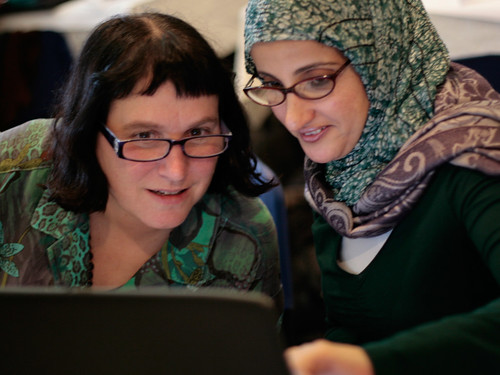
At SXSW and facilitating a panel called A Global Discussion About Networked Nonprofits and Free Agents, I introduced myself with this photo of me and Lena, the master trainer from Yemen for the E-Mediat Project. The photo shows us modeling “shoulder to shoulder” learning. Told the room that nonprofit capacity building was my calling.
Later, Michael Hoffman, who was in the audience, introduced me to his friends at “The Calling” and they suggested I write a guest post about anything I’m passionate about! So, here it is …
Last summer, at Craigslist Foundation Nonprofit Bootcamp, Chip Conley was the keynote speaker. He is the author of of ‘PEAK: How Great Companies Get Their Mojo from Maslow’, and founder and CEO of Joie de Vivre Hospitality
He spoke about leadership from the heart. He applies Maslow’s Hierarchy of Needs to his career in business and his leadership style.
One of the many inspiring things he shared in his talk was the phrase: “You can have a job, career, or calling.” It resonated.
His comment made me reflect over the past 32 years of working in the nonprofit sector. I had not planned to work in the nonprofit sector. In 1979, I was in music school as a classical flute performance major. I found myself more interested in what was going on backstage and than on stage – and followed my passion to working as an arts administrator of large and small nonprofit arts organizations in all different areas, including executive director of a small chamber orchestra. My passion was the opportunity for learning and that’s what motivated me.
In 1992, I discovered the Internet, Well, and was hired by the New York Foundation of the Arts to be the Network Weaver for a network for artists, Arts Wire. In my interview, I shared that I didn’t know a modem from microwave, but that I had the passion and curiosity to learn and teach others. They hired me and it turned into a decade of learning and teaching others (artists, arts organizations, and arts educators) how to integrate this technology into their work and organizations.
I had a chance to collaborate with every type of art form, arts management programs, arts education, and individual artists. It was always peer learning – I’d share about the technology and they’d teach me about their work. I learned an incredible amount from collaborating with arts teachers.
Since I believe that it is important to learn from adjacent practices, I started engaging with the nonprofit technology community in the late 1990’s when it was just a handful of people. In the early days, the nonprofit technology community was a small community of that was generously shared its knowledge and skills. (The same values hold true today over at NTEN).
In 2000, a nonprofit technology colleague introduced me to blogging and set up a blog on his server. Later, he introduced me to Typepad where I started Beth’s Blog in 2003. My blog started as my Trainer’s Learning Journal – a place to jot down practice and content related to building nonprofit technology capacity!
I feel blessed that what I have gotten paid to do over the past 32 years is something that I love, I’m passionate about, and highly motivated to do.
The above photo is one of my favorites. The E-Mediat project where Zoetica was hired to design and deliver the train the trainer’s session. It was a pleasure to work with experienced trainers – the energy and new ideas were fantastic. The photo captures a improvised moment in one of the sessions of modeling “Learning Over Each Other’s Shoulders” as Nancy White likes to call it.
I first heard the phrase ten years ago from a long-time nonprofit technology colleague, Andrew Gianni. He described the method as an alternative to technology lab classroom skills-based trainings. His definition:
A style in which the trainer acts as a peer to the student, physically sitting with the student and explaining technical concepts simply. There is a great psychological benefit to this style of training because it helps eliminate notions of superiority and inferiority, and brings the teacher to the same level as the student.

As a trainer and coach, my experience has been in the “doing” or delivery. Now, I finding my interests more in the “being” or train the trainers or process vs content. This lends itself to a more networked way of working, although it isn’t easy.
Is your work a job or career or is it a calling?
Note from Beth: This post is from the blog tour on the What’s Your Calling? Facebook Page You can subscribe for a chance to win a Calling Dream Kit including $200 in Amazon.com gift credit to buy supplies you’ll need as you pursue your calling, a DVD and poster of The Calling, and an hour of coaching to help plan your project and the chance to share your calling with the community. This post is cross posted on the site here.
